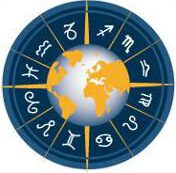Egypt and its capital Cairo in Astrology. Foundation charts, astrogeography and transits of the outer planets for Egypt.
Articles on political astrogeography & birth charts of nations: African Union + Capitals, Amsterdam, Ankara, Asian Capitals, Athens, Bagdad, Bangkok, Beijing, Belgrade, Berlin (en), (Berlin (dt), Bern, Brasilia, Brussels, Cairo, Canberra, Caracas, Copenhagen and Nuuk, Damascus, EU & European Capitals, Havana, Helsinki, Hongkong, lslamabad, Jakarta, Jerusalem, Kiev, Kabul, Lhasa, Lima, London, Madrid, Manila, Mexico City, Minsk, Moscow, Myanmar, New Delhi, New York, North American Nations, Ottawa, Paris, Prague, Pyongyang, Riyadh, Rome, Seoul, Stockholm, South American Nations, Taipei, Tehran, The Hague, Tripoli, Tokyo, UNASUR, United Nations, Vienna, Warsaw, Washington, Wellington,
Related articles: The Temple of Hathor at Dendera, The Karnak Temple of Amun Ra in Capricorn with Taurus, Gemini and Virgo: the Great Pyramid of Giza, Nabta Playa sun and star observatory in astrogeography, Howard Carter and the site of Tutankhamun`s burial chamber, Aquarius and Leo – The Capital of the Sun God Aten, Capricorn and Taurus – The Lighthouse of Alexandria,
Egypt and its capital Cairo in Astrology
The astrogeographical position of Cairo

Astrogeographical position of Cairo for morphogenetic field level 1 which describes the international and global resonance of the capital, political center and center of the national morphic field of Egypt: Cairo is located at 15° in creative, innovative air sign Aquarius the sign of the sky, heaven, stars, paradise, flying, strong winds, rain, innovation, revolution, abstraction, idealism and 29° in spiritual water sign Pisces the sign of imagination, dreaming, temples and together with Aquarius the strongest astrological indicator of floods.
The New Administrative capital of Egypt under construction
The new administrative Capital of Egypt at a construction site appr. 50 km east of Cairo was announced in 2015. Since Egypt has no means and technology to built the capital Its construction by Chinese architects and companies will be financed by the government of China, setting new standards for Chinese political and financial influence in Egypt, Suez Canal and the Middle East.

Astrogeographical position of the future capital of Egypt for morphogenetic field level 1 which explains the global resonance of the capital, administrative government, center of the national morphic field and global standing of Egypt: the construction site of the new capital is located at 22°Aquarius and 29°Pisces.

- at 12:00 noon of the day of the announcement the Moon as the astrological representative of the homeland, ancestor lines and the national morphic field as such was exactly conjunct the 17°Sagittarius resonance coordinate of the Chinese capital Beijing pointing at the Chinese origin of the whole project and the future capital.
- as the ruling planet of the Moon position in Sagittarius Jupiter the planet of victory, success and expansion was at 13° in highly centralist, royal fire sign Leo occupying an opposition to the 15°Aquarius resonance coordinate of Cairo. I have suggest long ago that together with Libra (polarity) Leo (centralism, absolutism) is to be considered as a central astrological resonator of Chinese culture.
- The combination of these aspects explains how strongly the new centralism of Egypt will be influenced by China.
List of Historical Capitals of Egypt
List of astrogeographical resonance coordinates of historical Capitals of Egypt.
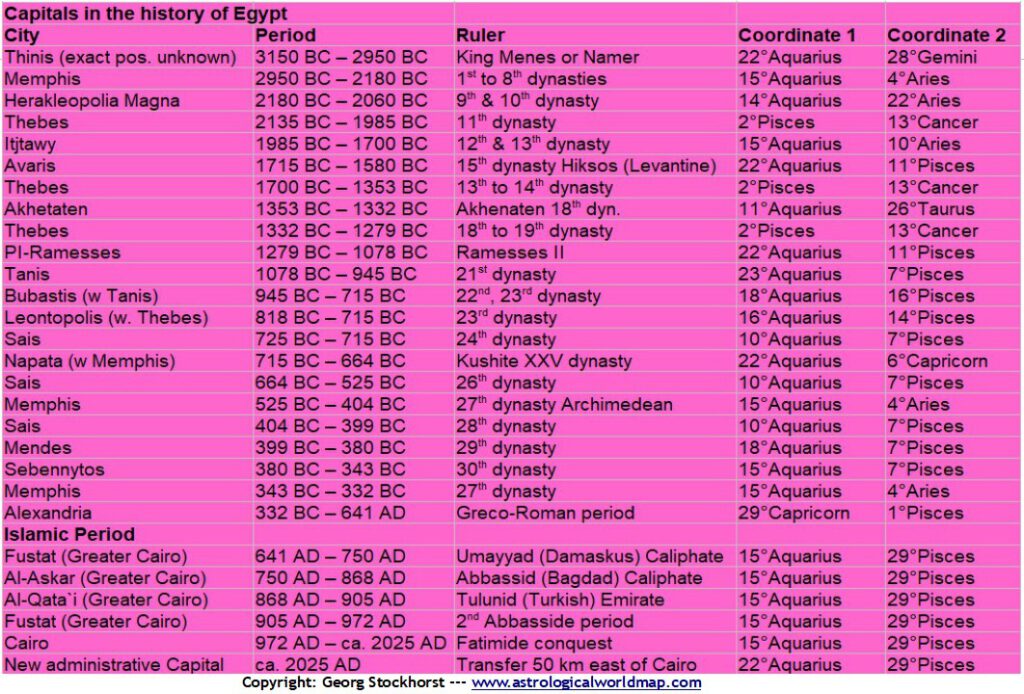
- One thing that can be seen from this list is the outstanding importance of the two spiritual and multicultural signs Aquarius and Pisces for the position of Egyptian capitals due to their correspondence with the astrogeographical longitude of the River Nile Valley. It can be concluded that Aquarius and Pisces have a strong impact on Egyptian history and culture particularly through their correspondence with flooding. At the same time i want to suggest to consider that this does not mean that these two signs represent the main indicators for Egyptian culture as such!!
- Basically Aquarius and Pisces stand for the central role of the Nile flood for Egyptian culture.
Natal and Historical Charts for Egyptian History
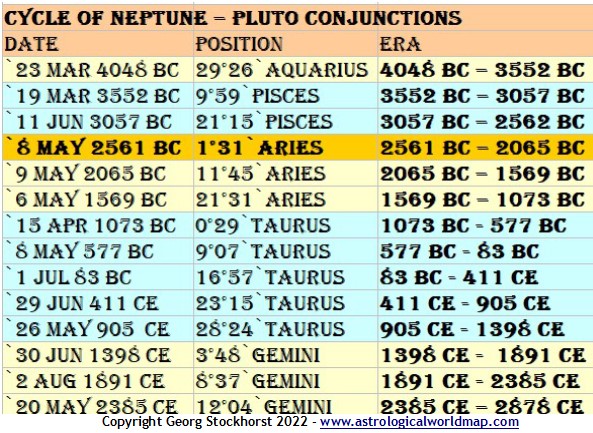
- Neptune-Pluto Conjunctions provide a natural cycle that can be applied to explore long-term developments in history.
- the table above shows how the position of the conjunctions advance through the zodiac signs.
- the conjunction of 8 May 2561 BC. is particularly important because it occurred right near the degree of the spring equinox at 0°Aries so starting a new terrestrial (global) “Year” of Pluto-Neptune conjunctions
- periods of Egyptian history that coincided with the beginning oft a new Neptune-Pluto cycle were:
- the beginning of the Middle Kingdom dated 2055 BC.
- the New Kingdom dated 1550 BC.
- the 3rd Intermediate Period dated 1077 BC. or 1069 BC
The Early Dynastic Period 3150 BC – 2686 BC
The Archaic or Early Dynastic Period – also known as Thinite Period, from Thinis, the supposed hometown of its rulers is the era immediately following the unification of Upper and Lower Egypt around 3100 BC.
The astrological chart and planetary positions for the Pluto-Neptune conjunction of 11 June 3057 BC should be consulted here in order to explore the transits
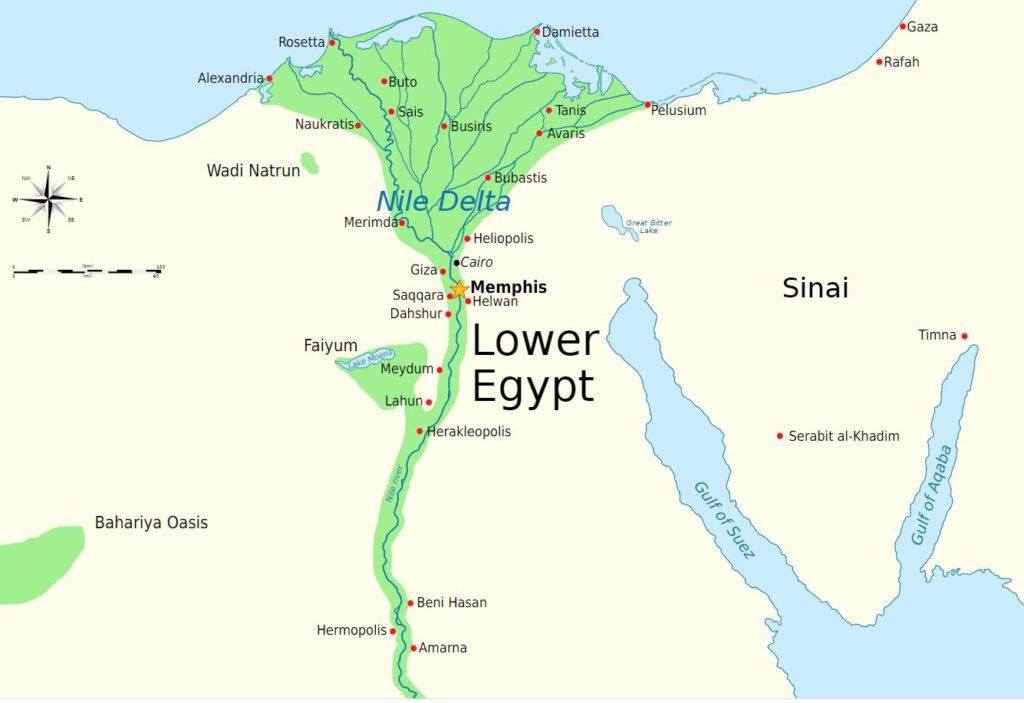
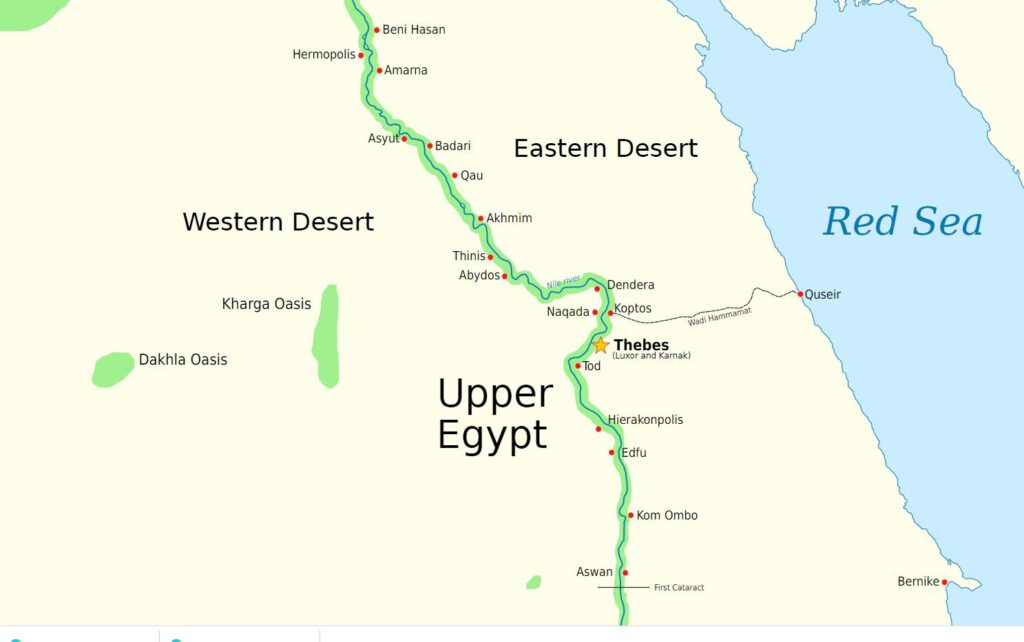
Taking into account the apparent importance of the cycle of Pluto-Neptune conjunctions for the ages of history of Egypt the conjunction of 11 June 3057 BC at 21°Pisces has to be investigated as a central indication of the developments at the foundation of the “Early Dynastic Period”.
The Old Kingdom 2668 B.C. – 2181 B.C
The Old Kingdom of Egypt is the period from the Third Dynasty to the Sixth Dynasty (2686–2181 BC.) is also known as the “Age of the Pyramid Builders of the Fourth Dynasty“, such as the kings Sneferu, Khufu, Khafre and Menkaure, who constructed the pyramids at Giza.
Under King Djoser the first king of the Third Dynasty of the Old Kingdom, the royal capital of Egypt was moved to Memphis located at 15°Aquarius and 3°Aries. A new era of building was initiated at Saqqara under his reign. King Djoser’s architect, Imhotep, is credited with the development of building with stone and with the conception of the step pyramid.
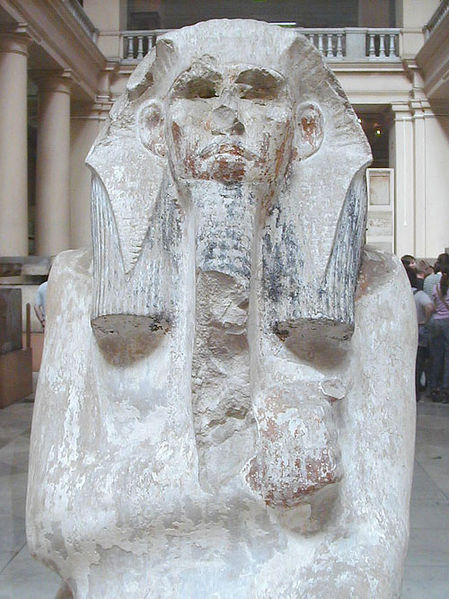
During the Old Kingdom, the King of Egypt (not called the Pharaoh until the New Kingdom) became a living god who ruled absolutely and could demand the services and wealth of his subjects. The exact year of the beginning of the reign of Pharao Djoser the founder of the Third Dynasty and the “Old Kingdom” is not certain.
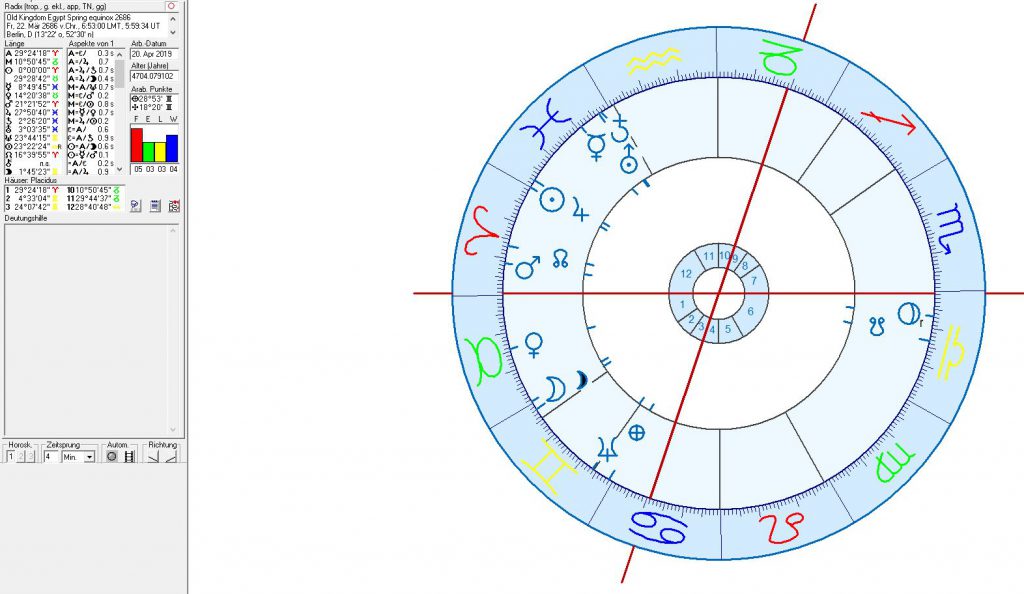
- But the planetary positions of the outer planets during the spring equinox of 2686 B.C. deliver an astrologically fascinating image in the form of a Uranus-Saturn conjunction between 2° and 3°Pisces the degrees of flooding (the main source of the Egyptian civilization) exactly conjunct the 2°Pisces astrogeographical resonance coordinate of the City of Thebes where the important central Karnak Temple of Amun-Re and the Valley of Kings are located.
- This planetary constellation relates to the significance of the yearly Nile flood (Uranus as the ruler of Aquarius on the degree of flooding) for the stability (Saturn) of Egyptian society. Uranus stands for the inflow of rain-waters,
- The important Imperial Karnak Temple of Amun-Re at Thebes (2°Pisces – 13°Cancer) was constructed not before the 18th dynasty (1550 B.C. -1297 B.C.) – over a thousand years after Djoser. It served as the central national and Egypt-wide temple for the state cult related to the annual fertility rites and the Nile flood.
- This transit coincidence between the foundation of the Old Kingdom and the astrogeographical position of Thebes should be investigated as a hint at the importance of
The first intermediate period 2181 BC. – 2055 BC.
The First Intermediate Period also called the ‘dark period’ in ancient Egyptian history began with the end of the Old Kingdom in 2181 BC. It comprises the Eighth, Ninth, Tenth, and part of the Eleventh Dynasties.
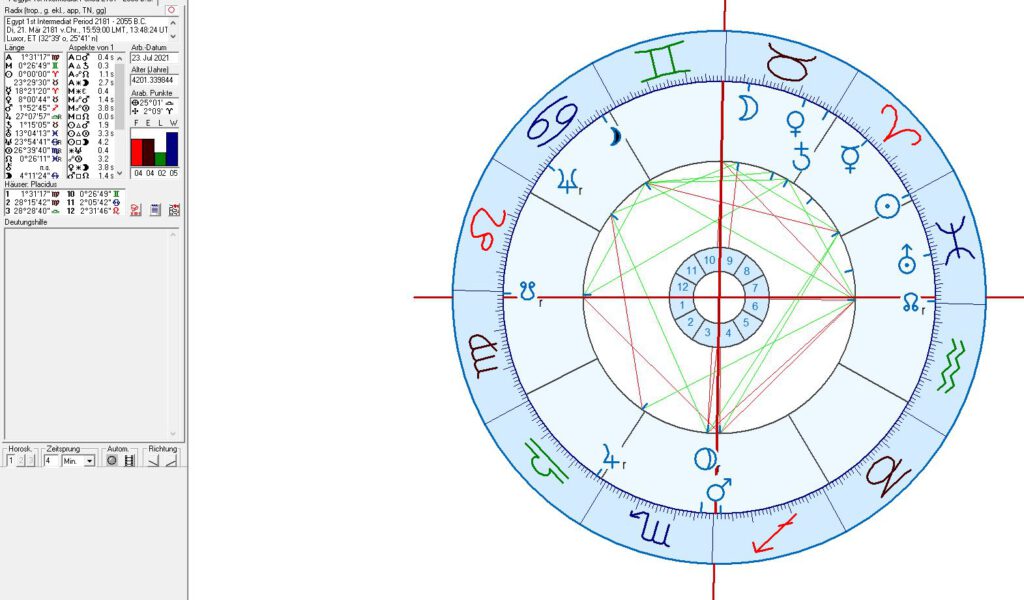
The Middle Kingdom of Egypt 2055 -1650 BC.
The Middle Kingdom (2055 or 2040 to 1782 or 1650 BC.) followed the political division during the First Intermediate Period. The Middle Kingdom began shortly before the reunification of Egypt in 38th or 39th year of the reign of Mentuhotep II (2060-2009 BC.) the 6th ruler in the Eleventh Dynasty. The kings of the Eleventh Dynasty ruled from Thebes and the kings of the Twelfth Dynasty ruled from el-Lisht.
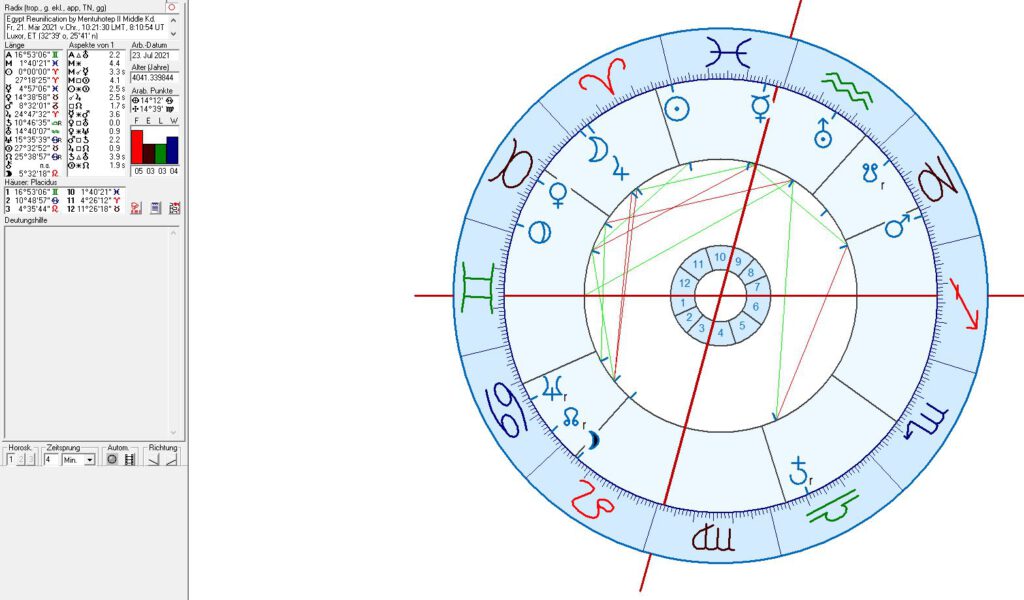
- the transit of Uranus the planet of globalization, emancipation and revolution over 15° of his own sign Aquarius and conjunct the 15°Aquarius resonance coordinate of the center of the national morphic field of united Egypt in Cairo explains the reunification of Egypt through Mentuhotep II in the years 2022-2020 B.C. as a plausible climax phase of an era of innovation and globalization.
- the transit of Neptune as indicator of the supra-national and cosmic morphic field as sign ruler over the 2°Pisces resonance coordinate of Thebes as well as the 29°Pisces coordinate of Cairo at 15°Cancer conjunct the 13°Cancer resonance coordinate of Thebes can be interpreted as a hint that the reunification of North and South Egypt included a reunification of multi-cultural and multi-ethnic groups.
- the transit can also be considered for astrological verification of the interpretation of Egyptian history because it represents a really strong explanation in support of the assumption that the reunification of Egypt under Mentuhotep II must have occurred in the years 2020 and 2021.
The 2nd Intermediate period 1650 – 1550 BC.
The Second Intermediate Period (1650-1550 B.C.) marks a period when ancient Egypt fell into disarray for a second time – this time through the invasion of the Hyksos people of Levantine origin under King Salitis who founded the 15th dynasty of ancient Egypt (1650-1550 B.C.) that ruled the largest parts of upper Egypt for ca. 100 years from Avaris (22°Aquarius-11°Pisces) with the exception of the Thebes region occupied by the 16th dynasty (1650-1590 BC.) and territories ruled by the 17th dynasty (1580-1550 B.C.).
The New Kingdom 1550 – 1069 BC.
The New Kingdom (also: Egyptian Empire) is the period between the sixteenth century BC and the eleventh century BC, covering the Eighteenth (1550 BC to 1290 B.C., Nineteenth (1292 BC to 1189 BC), and Twentieth dynasties (1189 BC to 1077 BC) of Egypt. Radiocarbon dating places the exact beginning of the New Kingdom between 1570 BC and 1544 BC. During the New Kingdom the territories of Egypt reached its largest extent, power and wealth.
The New Kingdom was begun through the foundation of the 18th dynasty by Ahmose I who completed the conquest and expulsion of the Hyksos, restored Theban rule over the whole of Egypt and its formerly subject territories of Nubia and Canaan. He reorganized the administration, reopened quarries, mines and trade routes and began massive construction projects.

- the chart for the winter solstice can be examined in two ways: as a chart for the natural conditions of the year 1049 BC or as a simple chart for the planetary positions of that era, particularly those of the slow moving outer planets who can serve as indicators of the zeitgeist.
- the most important long term transit in relation to the modern capital of Cairo was that of Pluto the astrological indicator of the zeitgeist in Taurus the sign agriculture, income, market places and the stabilization of the possession of territory into a square to the 15°Aquarius resonance coordinate of Cairo. Pluto in Taurus explains the priority of occupation of land, stabilization, construction work, fortifications, irrigation plants and of herding animals.
- Uranus at 11°Libra moving into a trine aspect to the 15°Aquarius resonance of Cairo stood for a stimulation through cultural and technological innovations.
Third Intermediate Period 1077/1069 BC–653 BC started with a Pluto-Neptune conjunction in Taurus
The Third Intermediate Period of ancient Egypt began with the death of Pharaoh Ramesses XI in 1070 BC. leading to a further decline of central power of kingship. Ramesses XI was succeeded as ruler of Lower Egypt by Pharao Smendes who is seen as the founder of the Twenty-First-Dynasty of Egypt.
Like the New Kingdom the beginning of the 3rd Intermediate Period too saw a transit of the 246-years cycle of Pluto into Taurus advancing towards the square position to the center of the Nile Valley and the modern capital of Cairo at 15° Aquarius . But this time the stabilizing perspective of Pluto in Taurus was questioned by a rare conjunction of Pluto with Neptune which occurs every appr. 495 years only.
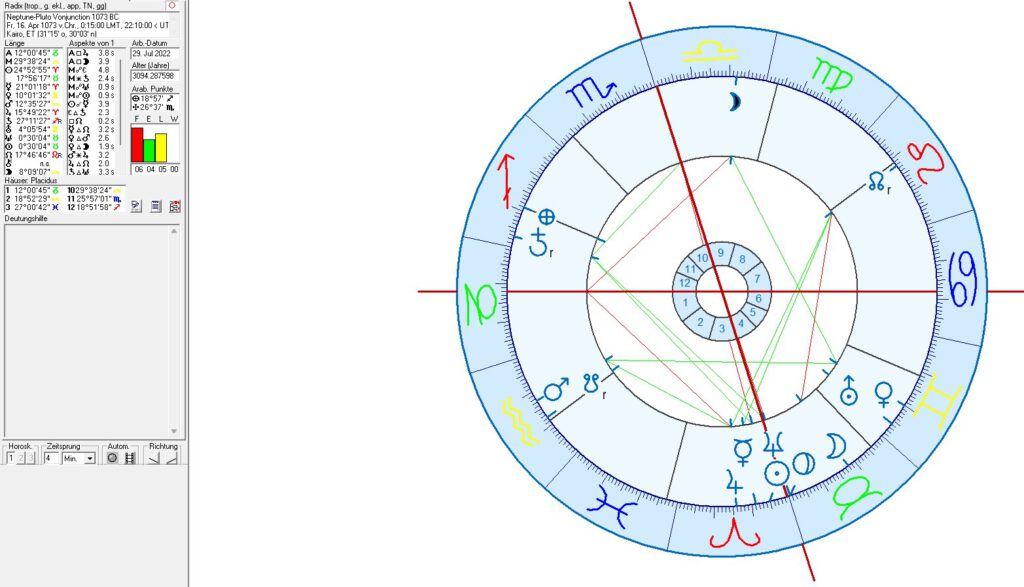
- the Neptune-Pluto conjunction of 16 April 1073 BC initiated a period of 2000 years in which these conjunction took place in Taurus the sign of agriculture
The Late Period of Ancient Egypt: 664/653 BC – 332 BC with Pluto conjunct Cairo & Neptune ingress in Scorpio
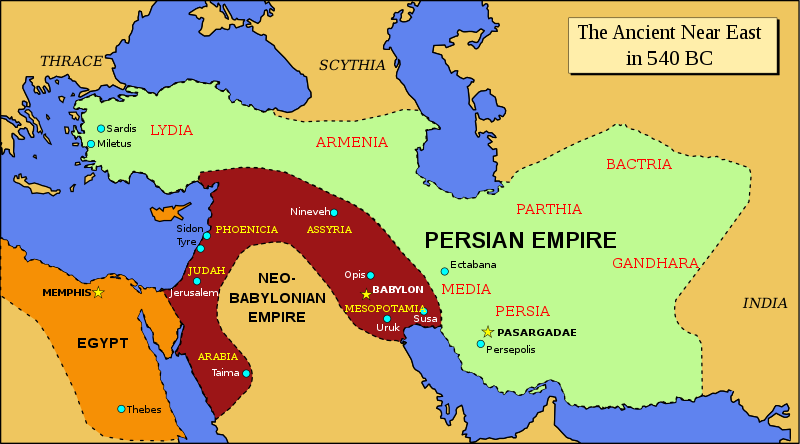
The term Late Period of ancient Egypt refers to the last flowering of native Egyptian rulers. It was started by Psamtik I through the foundation of the 26th Saite Dynasty. Psamtik ruled from the city of Sais in the Nile delta between 664–610 BC. The Late Period followed a period of Nubian rule and began with a short period of Neo-Assyrian suzerainty, with Psamtik I initially ruling as their vassal.

- Pluto at 13°Aquarius was conjunct the center of the national morphic field of modern Egypt in Cairo at 15° explaining the situation of foreign control and of seeking defense against it.
- Neptune as co-ruler of the Nile floods and ruler of the Nile delta area ingressed into Plutos sign of rulership Scorpio.
Greek and Ptolemaic period (332 BC–30 BC) began with a Pluto-Neptune opposition square to the 15°Aquarius position of Cairo
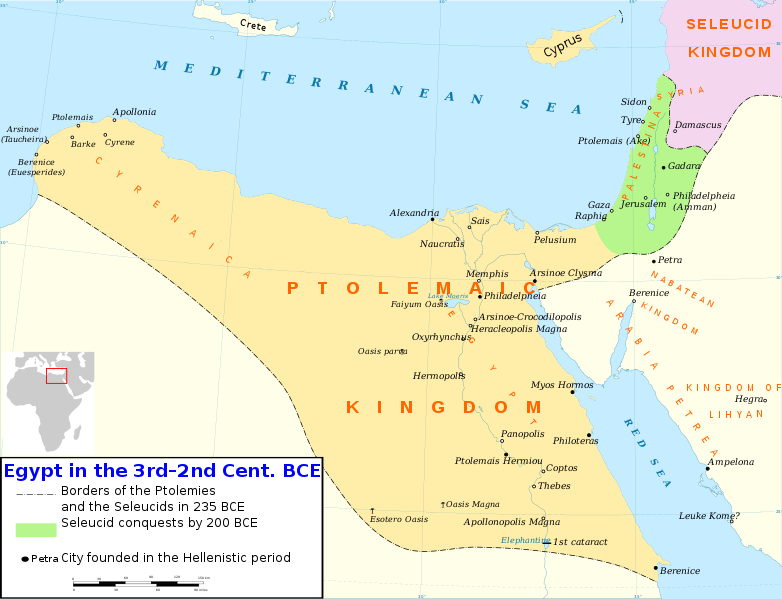
The decisive military event was before the Greek invasion of Egypt by Alexander the Great was the Siege and Conquest of Gaza in October 332 BC. It started the period to the Greek occupation of Egypt and the foundation of the Ptolemaic Kingdom by Ptolemy I Soter a companion of Alexander in 305 BC.
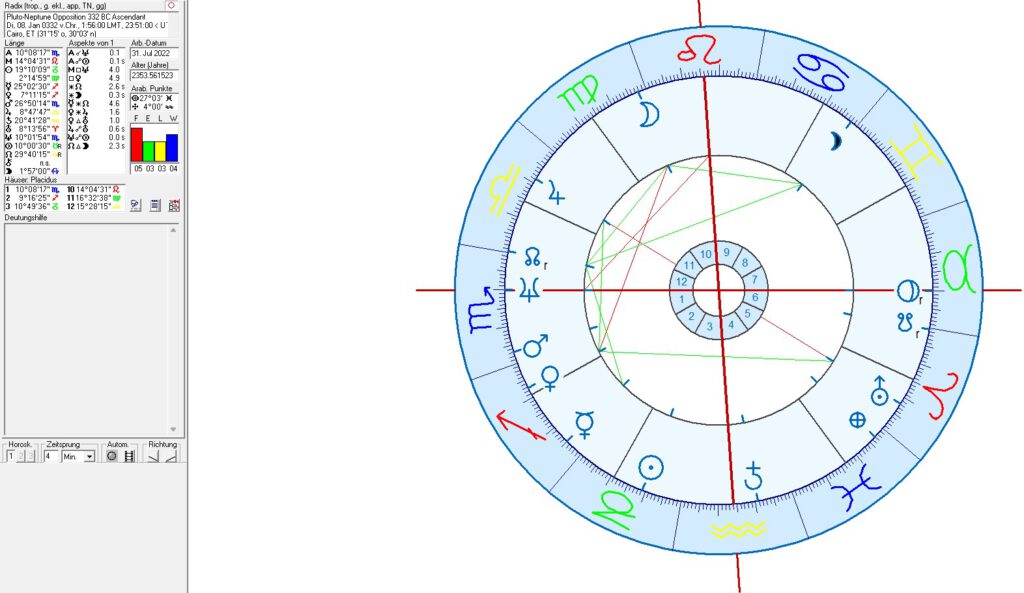
Roman period (30 BC – AD 641)
Egypt became a province of the Roman Empire in 30 BC, following the defeat of Mark Antony and Ptolemaic Queen Cleopatra VII by Octavian (later Emperor Augustus) in the Battle of Actium.
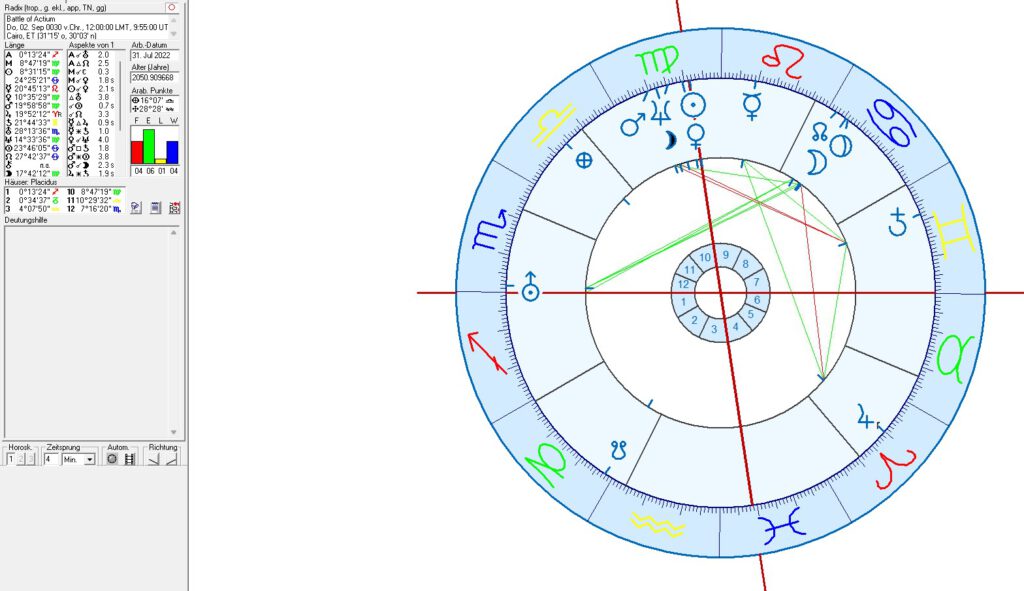
- Neptune at 14°Virgo in opposition to 15°Pisces the astrogeographical latitude (N-S) resonance sign of the Nile delta appears to have challenged the Egyptian control over the coast and Alexandria.
Islamic Conquest of Egypt in 641 AD with Pluto in Taurus square to Cairo
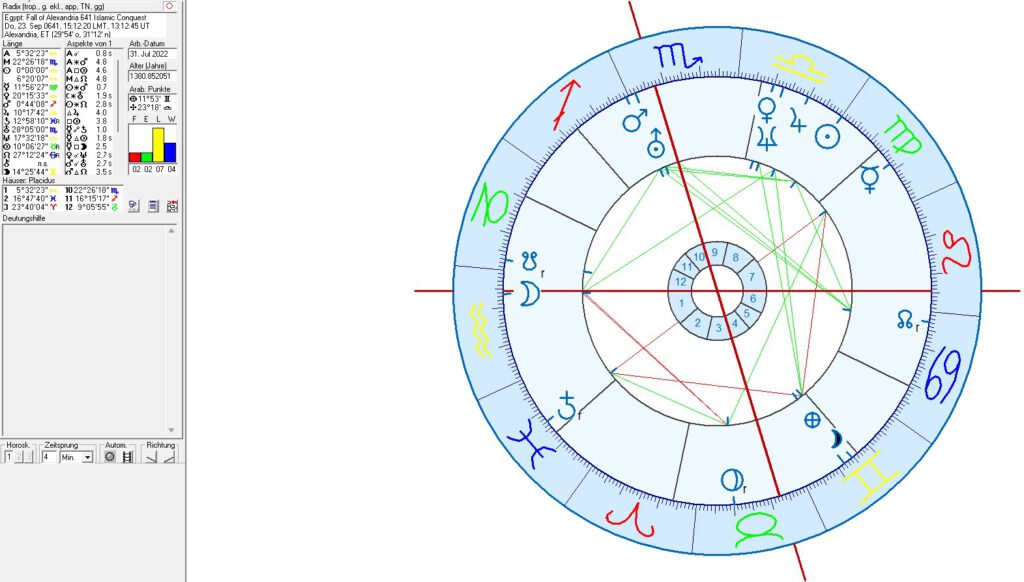
- Pluto at 10°Taurus took exactly the same position as during the conquest of Egypt by Alexander the Great in 332 BC moving towards the square position to the 15°Aquarius resonance coordinate of Cairo.
Birth Charts and History of Modern Egypt
From an astrogeographical point of view Neptune plays a important role in Egyptian politics as the ruler of the astrogeographical resonance coordinate of the capital Cairo in Pisces.
British Occupation of Egypt with Neptune square Cairo

The British occupation of Egypt was initiated through the British victory over the Egyptian army in the Battle of Tel El Kebir on 13 September 1882 with Neptune as the ruler of the Pisces coordinate of Cairo retrograde at 18°Taurus.

- Neptune squares indicate the destabilization of central rule, and territorial integrity.
- the British conquest of Cairo and Egypt in 1882 occurred with Neptune at 18°Taurus in square transit to the 15°Aquarius resonance coordinate of the capital and government in Cairo as a consequence of the climax of a destabilization process of territorial control of the Egyptian government between 1879 and 1882.
- Jupiter – the planet of victory, success and expansion was in exact square (pressure, tension) to the 29°Pisces resonance coordinate of status quo in Cairo from 29° in Gemini the sign of technology, roads and transport explaining the superior arms and transport technology of the British army as the reason for defeat.
Egyptian Independence of 1922 initialized by Neptune opposite Kairo
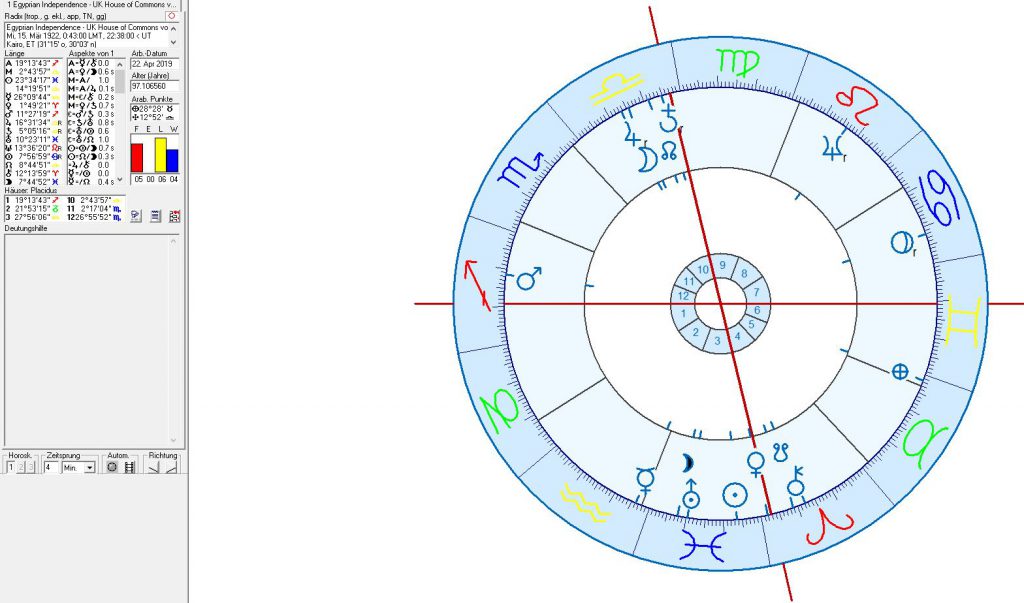
- The moment of the formal Egyptian independence of 1922 came with Neptune exactly opposite the 15°Aquarius resonance coordinate of Cairo putting pressure on the existing political hierarchy namely the rule of the British Consul-General.
- At the same time Jupiter`s stimulative and highly positive trine aspect to the 15°Aquarius position of Cairo from 16°Libra was strongly triggered by the transit of the Moon in conjunction with Jupiter in the early morning hours of that day. Despite the decision to give up the British Protectorate the British occupation of Egypt and esp. of the Suez canal area was continued.
Birth Charts for the Egyptian Republic of 1952-53

The 1st Coup d`Etat of 22 July 1952 was carried out with Mars the planet of soldiers at 11°Scorpio and Jupiter as indicator for financial profiteers at 18° in Taurus the sign of markets, income and wealth both square the 15°Aquarius resonance coordinate of the center of the national morphic field of Egypt. Jupiter explains the Egyptian Revolution of 1952 as part of a reaction on the pressure exerted onto the Egyptian government by financial profiteers.

The long – term transit from Pluto in opposition to the 15°Aquarius resonance coordinate of Kairo that explains the Egyptian revolution as part of a deeper transformation process of society had been at work since August 1947 when it had first reached its climax.

An astrological evaluation of the chart for the formal proclamation of the republic has to come to the conclusion that it was mainly a demonstrative act particularly dedicated at the abolition of monarchy. Neptune as sign ruler of the ascendant in Pisces conjunct Saturn on the aristocratic, courtly degrees of 20°Libra stood for the dissolution of the old monarchic system.
Nevertheless the Sun on the parliamentary degrees (25°-30°) of air sign Gemini the sign of personal liberty, effective equality, human rights, technical and intellectual progress explains the proclamation of the Republic as an important step in the direction of the modernization of society. The fast moving Sun was also the only astrogeographically relevant transit factor through its square to the 29°Pisces resonance coordinate of the capital. mercury as the sign ruler of the Sun and Jupiter positions in Gemini was conjunct Uranus the planet of revolution, globalization, abstraction and reconnection of society and the political system with its fuller potentials.
